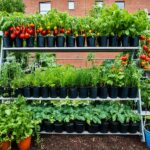vertical vegetable gardening systems
Maximizing Yield in the New Economy: A DIY Guide to Vertical Vegetable Gardening
Have you been trying to find a new way to get the most out of your time and space with your vegetable garden? Look no further than vertical vegetable gardening! In today’s new economy, maximizing yield and making the most of limited space is essential, and vertical gardening provides an innovative solution.
With our DIY guide to vertical vegetable gardening, you can explore the benefits of this technique and learn how to create your own productive vertical garden. Whether you have a small backyard, a balcony, or even just a sunny window, vertical gardening allows you to grow a variety of vegetables while utilizing vertical space effectively.
By utilizing vertical gardening techniques, you can achieve higher yields, conserve resources, and be more self-sufficient. Not only will you be able to grow a wider range of vegetables, but you’ll also save time and effort by optimizing plant growth and minimizing the need for sprawling garden plots.
Join the growing trend of vertical vegetable gardening and discover the rewards of this innovative approach. Our DIY guide will take you through the essentials of vertical gardening, from understanding the concept to setting up your own vertical garden. We’ll provide you with a list of vegetables that thrive vertically and discuss advanced techniques and systems to further enhance your yields.
Get ready to embark on a green journey, where you can enjoy fresh, organic produce right from your own vertical vegetable garden. Let’s dive into the world of vertical gardening and unlock the potential of your time and space. Get ready to maximize yield in the new economy!
Introduction
Welcome to the world of vertical gardening! If you have limited space but a desire to grow your own vegetables, vertical gardening is the perfect solution for you. This innovative approach allows you to maximize your yield in even the smallest of spaces, making it an ideal choice for urban dwellers and DIY gardening enthusiasts alike. In this section, we will explore the benefits of vertical gardening and why it should be your go-to option for small space gardening.
One of the key advantages of vertical gardening is its ability to make the most out of limited space. By growing your plants vertically, you can utilize walls, fences, or even a balcony railing to create a stunning and functional garden. This means that even if you only have a small terrace or a tiny balcony, you can still enjoy the satisfaction of growing your own fresh produce.
Not only does vertical gardening make efficient use of space, but it also leads to increased yields. The vertical structure of the garden allows plants to grow upwards, maximizing sunlight exposure and airflow. This optimized growing environment promotes healthier plants and, ultimately, a higher yield of fresh, homegrown vegetables.
Another reason to choose vertical gardening is its DIY-friendly nature. You don’t need to be an experienced gardener or have a green thumb to get started. With a little bit of knowledge and some creativity, you can create your own vertical garden right at home. It’s a rewarding project that allows you to connect with nature and reap the benefits of your efforts.
So, whether you have a small balcony, a terrace, or even just a tiny corner in your backyard, vertical gardening is a fantastic way to indulge in gardening and enjoy the bountiful rewards. In the next section, we will explore the fundamentals of vertical gardening, helping you understand how it works and how you can begin your own vertical gardening journey.
Understanding Vertical Vegetable Gardening
In order to successfully grow vegetables in a vertical garden, it’s important to have a solid understanding of how vertical gardening works and the key concepts behind it. By optimizing plant growth patterns and utilizing specific techniques and systems, you can create a thriving vertical garden that maximizes yield in limited spaces.
How Does Vertical Gardening Work?
Vertical gardening involves growing plants in an upright manner, enabling you to make the most of vertical space. Instead of traditional horizontal planting beds, vertical gardens utilize techniques and systems that take advantage of vertical surfaces such as walls, fences, or trellises. This allows for a more efficient use of limited space, making it an ideal option for urban environments or small backyards.
Vertical gardening concepts revolve around optimizing plant growth patterns to ensure proper sunlight exposure, air circulation, and nutrient absorption. By arranging plants vertically, you can create a layered system that maximizes productivity and minimizes the need for excessive space.
There are various vertical gardening techniques that you can employ, depending on your specific needs and available resources. Some popular techniques include:
- Container Vertical Gardening: Utilizing containers or pots attached to vertical structures to grow plants.
- Green Wall Systems: Installing modular panels with pockets for planting that can be attached to walls or fences.
- Trellis or Espalier Systems: Training plants to grow vertically along a support structure, such as a trellis or espalier.
- Hydroponics: Growing plants in a nutrient-rich water solution without the use of soil.
- Garden Towers: This efficient new technique allows very small areas to utilize an independent station to support several plants in a very small space.
Each of these systems has its own advantages and considerations. The choice of technique ultimately depends on factors such as available space, desired plant variety, and personal preference.
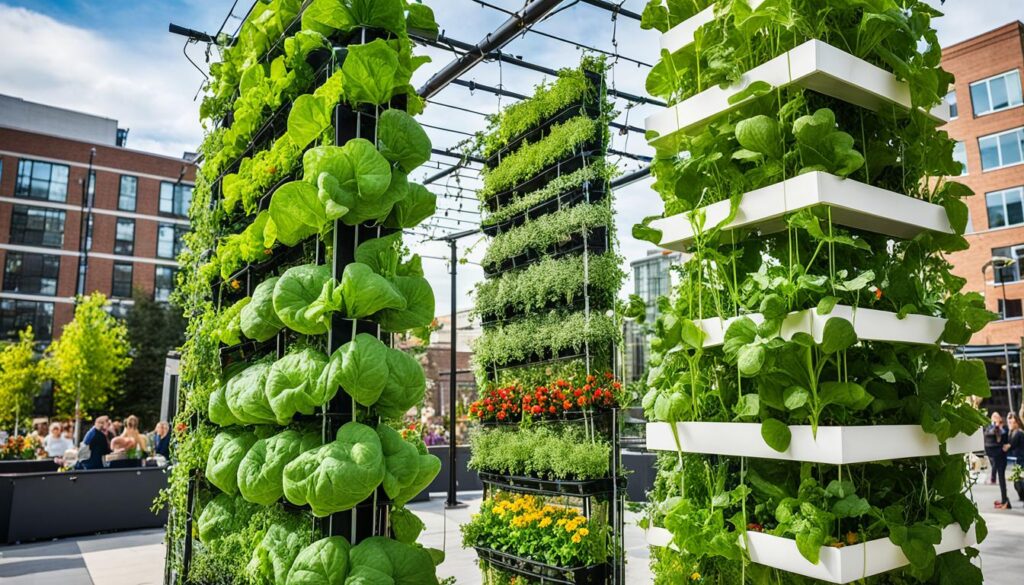
Vertical Gardening on Display
Utilizing these various vertical gardening techniques allows you to create a visually appealing and fruitful garden that maximizes yield while minimizing space requirements. Whether you choose to start with a simple container garden or explore more advanced systems like hydroponics, vertical gardening offers endless possibilities for cultivating your favorite vegetables.
| Technique | Description |
|---|---|
| Container Vertical Gardening | Utilizes containers or pots attached to vertical structures to grow plants. |
| Green Wall Systems | Modular panels with pockets for planting that can be attached to walls or fences. |
| Trellis or Espalier Systems | Training plants to grow vertically along a support structure, such as a trellis or espalier. |
| Hydroponics | Growing plants in a nutrient-rich water solution without soil. |
Setting Up Your Vertical Vegetable Garden
In order to successfully set up your vertical vegetable garden, choosing the right location and materials is crucial. The location will determine the amount of sunlight and accessibility your plants will receive, while the materials will ensure the stability and functionality of your vertical garden design. Here are some tips to help you make informed choices:
Choosing the Right Location
When selecting the location for your vertical garden, consider the following:
- Sunlight: Find a spot that receives adequate sunlight for the vegetables you plan to grow. Most vegetables require at least 6 hours of direct sunlight each day.
- Accessibility: Choose a location that allows easy access for watering, harvesting, and maintenance. Consider the height of your vertical garden and ensure it’s within reach.
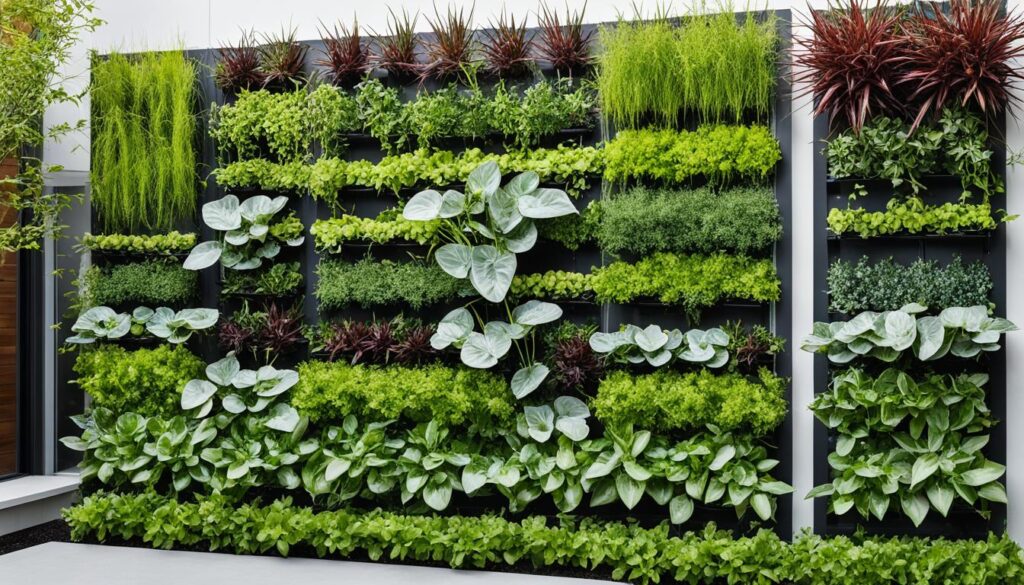
Vertical Garden Wall Design
Choosing the Right Materials
When it comes to vertical gardening, selecting the right materials is essential for the success and durability of your garden. Consider the following:
- Support Structure: Determine the type of support structure you will need for your vertical garden. Options include trellises, wall-mounted frames, or modular systems.
- Containers: Choose containers that are suitable for vertical gardening. Consider factors such as drainage, size, and material. Vertical garden planters or pocket systems are popular choices for maximizing space.
- Growing Medium: Select a suitable growing medium that provides proper aeration, drainage, and nutrient retention for your plants. Options include potting soil, coco coir, perlite, or a combination.
- Irrigation System: Decide on an efficient irrigation system that ensures your plants receive adequate water. Options include drip irrigation, vertical garden irrigation kits, or self-watering systems.
By carefully selecting the location and materials for your vertical vegetable garden, you can create an efficient and visually appealing space that maximizes your plant’s growth and yield.
Vegetables That Thrive Vertically
Vertical gardening opens up a world of possibilities for growing a wide variety of vegetables in limited spaces. Here, we’ve curated a list of the best vegetables for vertical gardening, along with some creative ideas and inspiration for vertical vegetable gardening combinations and layouts. Whether you have a small balcony or a spacious backyard, these vegetables can be successfully grown vertically, maximizing your yield and enhancing your gardening experience.
1. Tomatoes: Tomatoes are an excellent choice for vertical gardening. They can be trained to grow vertically using stakes, trellises, or cages. Look for compact varieties like ‘Patio’, ‘Tiny Tim’, or ‘Cherry Cascade’ that are specifically bred for container and vertical gardening.
2. Cucumbers: Cucumbers are another popular option for vertical gardening. Their vines can be trained to climb up trellises or fences, saving space and allowing for easier harvesting. Varieties like ‘Pick a Bushel’ or ‘Bush Champion’ are compact and well-suited for vertical growth.
3. Beans: Both pole beans and bush beans can be grown vertically. Pole beans, such as ‘Kentucky Wonder’ or ‘Scarlet Runner’, naturally climb and thrive when provided with trellises or other vertical supports. Bush beans can be grown in containers or raised beds with the help of stakes or trellises.
4. Peas: Peas are cool-season vegetables that can be vertically grown in early spring or fall. Use trellises or netting to support the climbing vines. Varieties like ‘Sugar Snap’ or ‘Oregon Sugar Pod’ are delicious and perfect for vertical gardening.
5. Squash: While most squash varieties are sprawling plants, certain compact types can be grown vertically. Look for bush varieties like ‘Honeybaby’ or ‘Patty Pan’, which require less space and can be trained to grow vertically with the help of sturdy supports.
6. Pole Beans: As the name suggests, pole beans naturally require vertical support for their climbing vines. Varieties like ‘Blue Lake’ or ‘Climbing French’ are renowned for their productivity and can be easily cultivated using trellises or teepees.
Try combining different vertical vegetable plants in your garden to make the most of the available space. For example, you can grow tomatoes and basil together, creating a visually appealing and productive vertical garden. Be adventurous with your vertical vegetable gardening ideas and don’t be afraid to experiment with different plant combinations and layouts.
Now that you know which vegetables thrive vertically, it’s time to get creative with your own vertical vegetable garden. Let your imagination run wild as you design, plant, and tend to your vertical garden, enjoying the bountiful harvests that come with this innovative gardening technique.
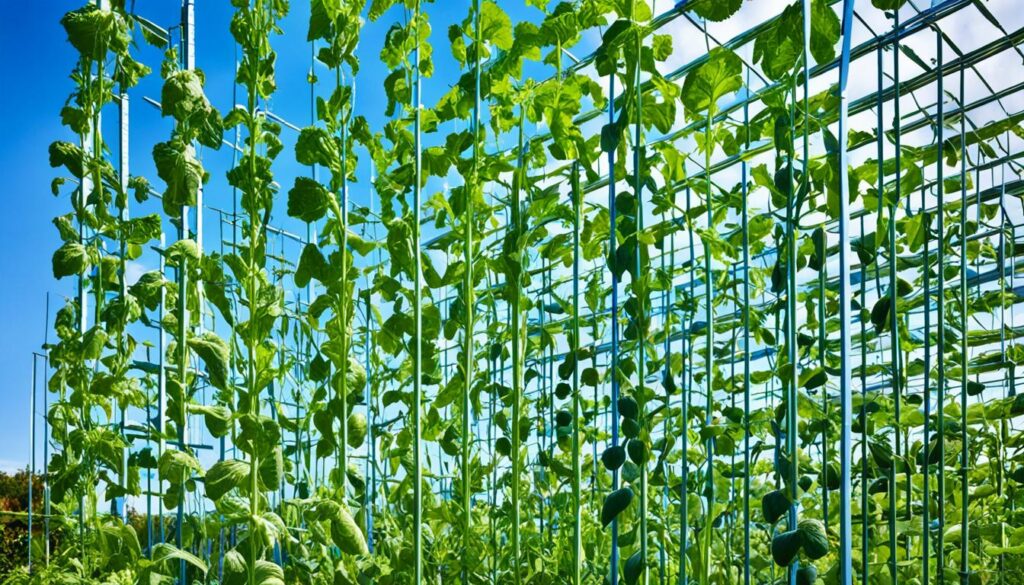
Vertical Gardening Systems and Techniques
In advanced vertical gardening, gardeners employ sophisticated systems and techniques to maximize space utilization and improve plant yield. These innovative solutions open up a world of possibilities for creating thriving vertical gardens.
One such advanced technique is hydroponics, a soil-less system that delivers nutrients directly to plant roots through a water-based solution. Hydroponics allows for precise control over nutrient levels, water supply, and pH balance, ensuring optimal growing conditions for plants. This technique eliminates the need for traditional soil, making it an efficient and space-saving choice for vertical gardens.
Hydroponics is especially useful in smaller spaces where soil is scarce. It allows gardeners to cultivate a wide variety of plants in a controlled environment, resulting in faster growth and higher yields.
Aero-ponics is another cutting-edge vertical gardening technique. This method suspends plants in air, with their roots exposed to a fine mist of water and nutrients. By delivering the necessary elements directly to the roots, aero-ponics promotes optimal nutrient absorption and enables plants to grow faster and stronger.
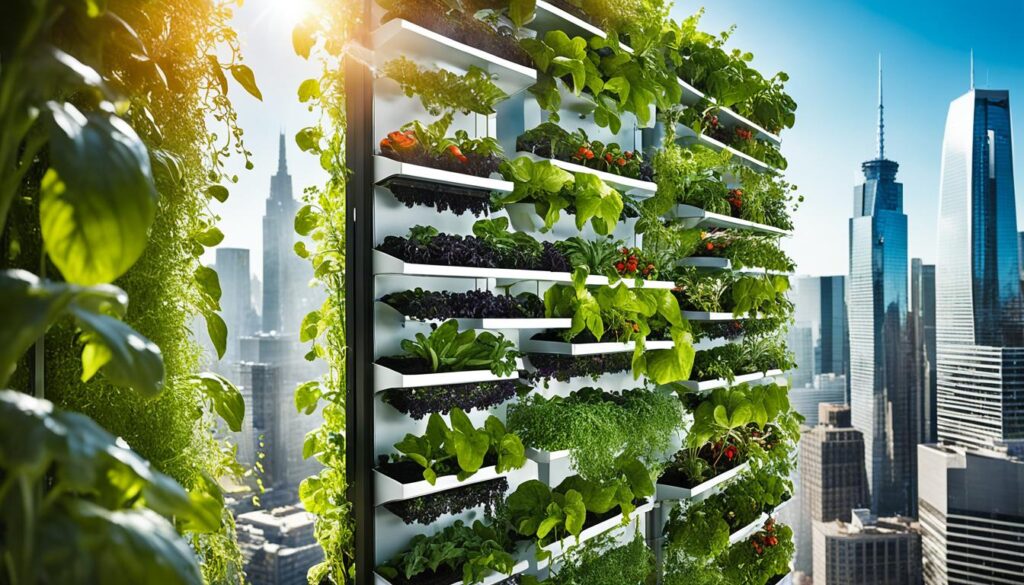
To further enhance vertical gardening systems, innovative solutions like vertical trellises, stackable planters, and modular vertical garden structures have emerged. These solutions offer flexibility in garden design, making it easier to adapt to different plant sizes and growth patterns. Additionally, vertical farming techniques such as vertical hydroponic towers enable gardens to flourish in limited spaces, such as urban environments.
By embracing advanced techniques and systems, gardeners can explore new frontiers in vertical gardening, taking full advantage of vertical space and achieving remarkable results in yield and plant growth. These sophisticated and innovative approaches pave the way for a more efficient and sustainable way of growing vegetables and other plants.
Growing Vertically on a Terrace or Balcony
When it comes to vertical gardening, balconies and terraces are excellent spaces to explore. With limited outdoor areas, maximizing space becomes crucial. By implementing vertical gardening techniques, you can create a lush, green oasis even in small settings. In this section, we will provide you with valuable tips and strategies for vertical gardening on your balcony or terrace.
Tips for Vertical Gardening in Small Outdoor Spaces
1. Choose the right plants: Opt for plants that are well-suited for container gardening, such as herbs, salad greens, and compact vegetables. Consider factors like sunlight requirements, growth habits, and the amount of space each plant needs to thrive.
2. Use vertical structures: Utilize trellises, hanging baskets, and wall-mounted planters to maximize vertical space. These structures not only add visual interest but also provide additional growing areas for your plants.
3. Select suitable containers: Use lightweight and space-saving containers like hanging pots, window boxes, or vertical planters specifically designed for small spaces. Ensure the containers have proper drainage to avoid waterlogging and root rot.
4. Optimize sunlight: Position your plants in areas that receive adequate sunlight. Observe the sun’s movement throughout the day to make the most of available light. If your balcony or terrace lacks direct sunlight, consider using grow lights or selecting shade-tolerant plants.
5. Implement vertical gardening techniques: Train vines and climbers to grow vertically by providing them with trellises or stakes. Utilize the technique of espalier to train fruit trees against walls. This not only saves space but also creates a beautiful backdrop on your terrace or balcony.
6. Watering and fertilizing: Vertical gardens may require more frequent watering due to increased exposure to sunlight and wind. Ensure proper irrigation by installing drip irrigation systems or hand-watering regularly. Fertilize your plants with organic fertilizers to promote healthy growth.
7. Vertical garden maintenance: Regularly monitor your plants for pests and diseases. Prune and trim as needed to maintain the desired shape and prevent overcrowding. Remove dead leaves and flowers to encourage new growth.
By incorporating these tips and strategies, you can transform your balcony or terrace into a thriving vertical garden. Enjoy the beauty of nature and the satisfaction of harvesting your own fresh produce in these small outdoor spaces.
Common Challenges and Solutions
In vertical gardening, various challenges and problems can arise, affecting the health and productivity of your plants. By understanding these common challenges and implementing effective solutions, you can maintain a thriving vertical garden. Here are some troubleshooting tips and solutions to help you overcome vertical gardening hurdles.
Troubleshooting and Solutions for Vertical Gardens
- Pest Control: One of the most common challenges in vertical gardening is the presence of pests. To control pests, regularly inspect your plants for any signs of infestation, such as yellowing leaves or chewed foliage. Implement organic pest control methods, such as introducing beneficial insects or using homemade natural repellents.
- Watering Techniques: Watering your vertical garden appropriately can be crucial for plant health. Overwatering can lead to root rot, while under-watering can result in dehydration. Maintain proper moisture levels by monitoring the soil moisture and adjusting watering frequency accordingly. Consider using self-watering systems or drip irrigation to ensure consistent hydration.
- Maintenance Practices: Proper maintenance is essential for the overall well-being of your vertical garden. Regularly prune your plants to encourage healthy growth and prevent overcrowding. Remove any dead or diseased foliage to maintain optimal plant vitality. Additionally, regularly clean your vertical garden system to prevent debris buildup and potential disease transmission.
- Plant Nutrient Imbalance: Nutrient deficiencies or imbalances can impact the growth and productivity of your plants. Monitor the nutrient levels in your vertical garden and address any deficiencies through targeted fertilization. Consider using organic fertilizers, compost, or foliar sprays to provide the necessary nutrients to your plants.
By implementing these troubleshooting tips and solutions and being proactive in your vertical garden care, you can overcome common challenges and maintain a thriving vertical garden.
Conclusion
Vertical vegetable gardening offers a multitude of benefits that can help gardeners maximize their yield in the new economy. Throughout this article, we have explored the advantages of vertical gardening, from its ability to make the most of small spaces to its potential for increased yield.
By understanding the concepts and techniques behind vertical gardening, readers can confidently set up their own vertical vegetable gardens. Selecting the right location and materials, choosing suitable vegetables, and utilizing advanced systems and techniques are all essential elements for success in vertical gardening.
Despite the challenges that may arise, such as pest control and maintenance, there are always solutions available for vertical gardeners. Our comprehensive guide provides troubleshooting tips and advice to overcome these common obstacles.
In summary, vertical gardening offers a sustainable and efficient solution for gardeners of all levels of experience. Its benefits are far-reaching, allowing individuals to grow fresh and nutritious produce while maximizing available space. We encourage readers to embrace the world of vertical gardening and experience the joy of cultivating their own thriving garden, no matter the constraints of their surroundings.
Call To Action
Now that you have learned the ins and outs of vertical gardening, it’s time to take the next step in your gardening journey. Don’t stop here; there is so much more to explore and discover in the world of vertical gardening.
To further enhance your knowledge and get additional support, we recommend exploring the following resources:
- Books: Dive deeper into vertical gardening with acclaimed books such as “The Vertical Gardening Guide” by Susan Berry and “Vertical Gardening: Grow Up, Not Out, for More Vegetables and Flowers in Much Less Space” by Derek Fell.
- Websites: Visit websites like verticalgardening.com and urbanfarmersguide.com for valuable tips, techniques, and inspiration from experienced vertical gardeners.
- Communities: Join online communities such as the Vertical Gardening Forum on Facebook or the Vertical Gardening subreddit to connect with fellow gardening enthusiasts, share experiences, and seek advice.
Remember, the journey to becoming a successful vertical gardener is an ongoing one. Keep experimenting, learning, and growing as you embark on this rewarding gardening adventure.
FAQ
What is vertical vegetable gardening?
Vertical vegetable gardening is a technique that involves growing vegetables in a vertical space, such as on walls, trellises, or in stacked containers. It maximizes space and allows for higher yields in small areas.
What are the benefits of vertical gardening?
Vertical gardening is advantageous for small spaces as it maximizes available area for growing. It also increases yield, allows for better air circulation and sunlight exposure, and makes harvesting and maintenance easier.
Which vegetables are suitable for vertical gardening?
Many vegetables thrive in vertical gardens, including tomatoes, cucumbers, beans, peas, peppers, and squash varieties. These vegetables grow on trellises or vines and are well-suited for vertical gardening systems.
How can I start my own vertical vegetable garden?
To start a vertical vegetable garden, you need to choose a suitable location with ample sunlight, select the right materials for vertical gardening, and design an efficient and visually appealing layout. You can use containers, trellises, or specially designed vertical gardening systems.
What are some advanced techniques for vertical gardening?
Advanced techniques for vertical gardening include hydroponics and aeroponics, which allow for soilless cultivation and maximize space utilization. These systems provide precise nutrient delivery to the plants and enable year-round gardening.
How can I create a vertical garden on my balcony or terrace?
To create a vertical garden on a balcony or terrace, you can utilize hanging pots, vertical planters, or trellises attached to walls or railings. Choosing compact plants and lightweight containers is essential for small outdoor spaces.
What are common challenges in vertical gardening and how can I overcome them?
Common challenges in vertical gardening include pest control, watering, and maintenance. To overcome these issues, you can adopt integrated pest management practices, use self-watering systems, and regularly monitor the health of your plants.
What are the benefits of vertical gardening?
Vertical gardening allows for maximum yield in limited spaces, enhances aesthetics, and offers better air circulation and sunlight exposure for plants. It also provides an opportunity for sustainable and self-sufficient gardening.
Where can I find additional resources and support for vertical gardening?
To get additional resources and support for vertical gardening, you can explore books, websites, and online communities dedicated to the topic. Some recommended resources include books like “Vertical Vegetables and Fruit” by Rhonda Sherman and websites like gardentowerproject.com.
Source Links
- 10 Must-Have Blooms for Your 2025 Garden
- The Health Advantages of Gardening You Need to Know
- How to Create a Small Vegetable Garden Layout Plan: A Beginner’s Guide
- DIY Garden Projects for Small Spaces: Upcycling Ideas to Maximize Your Garden
- Watering Techniques for Small Gardens: Ensuring Your Plants Thrive
- Small Border Plants for Landscaping: Adding Beauty and Functionality to Your Garden
- Year-Round Small Space Gardening: Seasonal Planting Tips for Maximum Harvest
- Essential Tools for Small-Space Gardening: What You Really Need
- The Ultimate Guide to Container Vegetables: What to Grow in Small Spaces
- Budget-Friendly Gardening: How to Create a Thriving Garden on a Tight Budget
- How to Optimize Sunlight in Small Gardens: Tips for Better Plant Growth
- DIY Vertical Planters: Creative Ideas for Small Space Gardening
- Companion Planting for Small Vegetable Gardens: Boost Growth and Deter Pests
- Container Gardening Essentials: Choosing the Right Pots, Soil, and Plants
- Vertical Gardening Techniques: Maximizing Your Small Space with Climbers and Vines
- How to Build a Raised Bed Garden in a Small Backyard: Step-by-Step Guide
- The Best Vegetables for Small-Space Gardens: High-Yield Varieties You Need to Grow
- Smart Vegetable Garden Layouts for Small Spaces: Maximizing Your Green Thumb in Compact Areas
- 40. Best Practices for Managing a Sustainable Garden Year-Round
- Building a Wildlife Pond for Biodiversity
- Advanced Techniques in Sustainable Gardening
- How to Create a No-Till Garden
- The Mental Health Benefits of Gardening
- Using Technology to Enhance Sustainable Gardening
- Getting Certified Organic: Steps and Benefits
